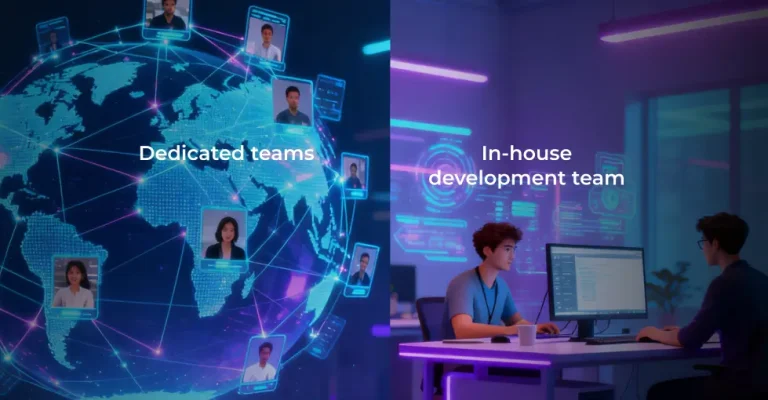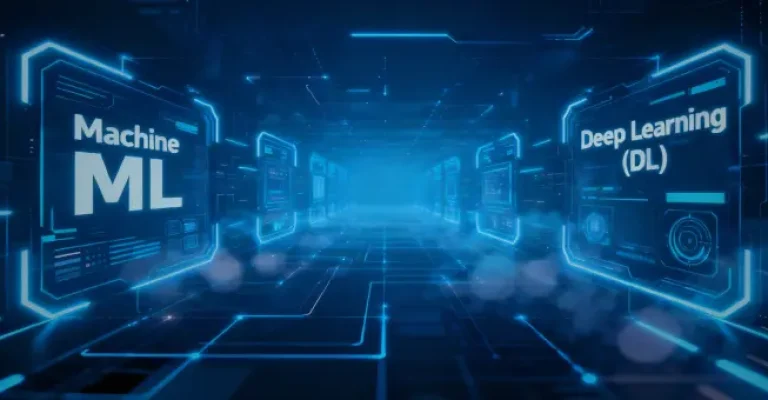The pressure to innovate faster has never been greater. AI, cloud, and other emerging technologies are reshaping entire industries in months, forcing companies to adapt product strategies, team capabilities, and delivery speed in real time.
The dedicated development team model has been part of the IT landscape for over 20 years, evolving into a proven, long-term collaboration approach where a group of specialists works exclusively on a client’s project. Today, 92% of Forbes Global 2000 companies engage in IT outsourcing, with dedicated teams among the most effective models for maintaining innovation momentum. This approach enables organizations to integrate cross-functional experts quickly, scale up or down without disruption, and allocate internal resources to strategic priorities.
This guide provides a comprehensive roadmap for managing a dedicated development team — including when it’s the right choice, when it’s not, and how to maximize benefits.
What is a dedicated development team?
A dedicated development team model represents long-term outsourcing engagements where a group of external software professionals works exclusively on your project or product. Unlike traditional outsourcing strategies, this model fosters a genuine partnership where the remote team becomes deeply integrated with your business processes, goals, and culture.
The meaning of “dedicated team” as a term encompasses several key characteristics:
- Exclusive focus: team members work solely on your project, ensuring undivided attention and a deep understanding of your business needs.
- Long-term collaboration: partnerships typically span months or years, allowing for relationship building and knowledge accumulation.
- Shared ownership: while technically external, the team operates with the same commitment and accountability as internal employees.
- Flexible structure: teams can be scaled up or down based on project requirements and business needs.
Dedicated teams vs. other engagement models
Understanding how the dedicated development team model compares to other approaches helps clarify when it’s the right choice for your organization.

Turnkey outsourcing works best for well-defined projects with clear requirements and deadlines. However, its fixed-price model and limited control over the external development process lack flexibility, which makes it unsuitable for agile project environments.
Staff augmentation allows companies to integrate external software experts into existing teams, expediting product development and boosting cost-efficiency. Companies maintain direct control over their external experts and need to invest management resources into process coordination, motivation, upskilling, and more.
End-to-end development focuses on the use of autonomous, cross-functional solutions teams which assume full responsibility over complete products or complex functionality. Solutions teams offer more flexible pricing structures and more granular reporting and control over the delivery process, which makes this strategy distinct from turnkey outsourcing.
Dedicated teams strike an optimal balance between staff augmentation and end-to-end development, providing high control over talent sourcing and the product development process. Typically, remote dedicated teams collaborate closely with the clients’ internal resources while assuming ownership over the delivery of product verticals and features.
Dedicated team architecture and roles
Creating an effective dedicated development team requires understanding the specific roles and how they contribute to project success. The optimal team composition depends on your project’s complexity, technology stack, and business requirements.
Core roles
Project manager
- Coordinates daily operations and sprint planning
- Manages stakeholder communication and expectations
- Tracks progress against milestones and budgets
- Identifies and mitigates project risks
- Facilitates team collaboration and problem-solving
Software developers (frontend/backend/full-stack)
- Write, test, and maintain application code
- Participate in architecture decisions and code reviews
- Implement features according to specifications
- Optimize performance and ensure security standards
- Collaborate with designers and QA engineers
- Develop and execute comprehensive testing strategies
- Create automated test suites and maintain test environments
- Identify, document, and verify bug fixes
- Ensure compliance with quality standards and requirements
- Perform user acceptance testing coordination
- Create user-centered design solutions and prototypes
- Conduct user research and usability testing
- Develop design systems and style guides
- Collaborate with developers on implementation feasibility
- Ensure consistent user experience across platforms
Other specialists
- AI and data experts: indispensable for any project involving large datasets, complex algorithms, and the need for intelligent automation or predictive capabilities.
- DevOps engineers: essential for projects requiring complex deployment pipelines, cloud infrastructure management, or high-availability systems.
- Business analysts: valuable when bridging complex business requirements with technical implementation, particularly in enterprise environments.
- Solution architects: critical for large-scale systems, integration projects, or when working with legacy systems requiring careful architectural planning.
- Creative content specialists: valuable in entertainment industry projects where dedicated teams combine AI with visual effects; for example, a game development company integrates such experts for procedural generation and art assets in long-term developments.
What is the ideal dedicated team composition?
Effective dedicated development teams require a careful balance of technical skills, experience levels, and domain expertise.
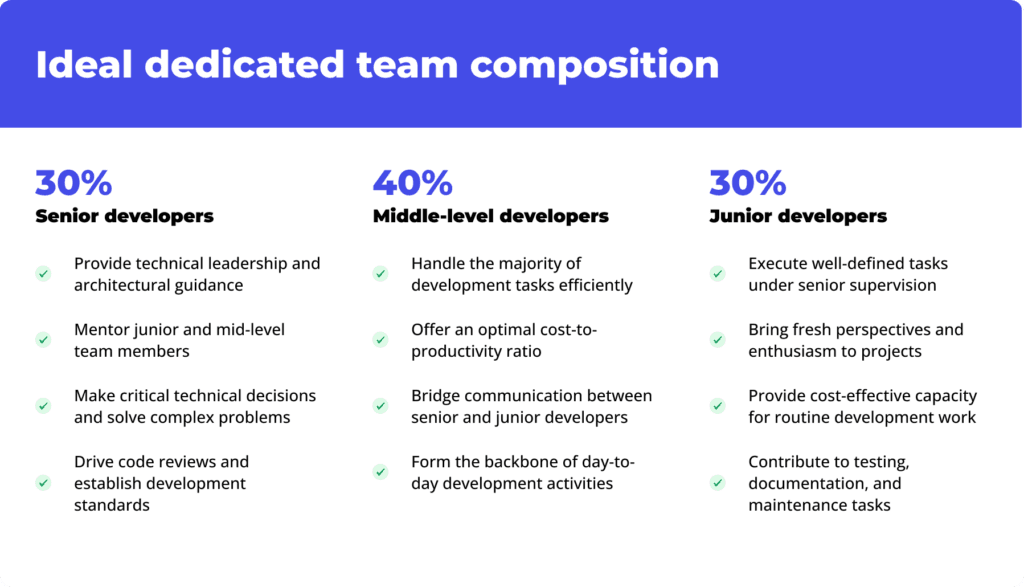
This 30-40-30 distribution maximizes both cost efficiency and technical capability while ensuring knowledge transfer, team stability, and sustainable skill development within the team.
When to engage dedicated teams: use cases
To help IT leaders make strategic decisions aligned with business objectives, it’s crucial to understand when dedicated teams offer the greatest value. While not exhaustive, the following are key examples of scenarios where dedicated teams can deliver maximum benefit.
1. Startup scenarios
An IoT startup with $120,000 in pre-seed funding leveraged AgileEngine’s dedicated team to extend its runway while building flagship products. In just three months, our team delivered a fully functional MVP — including backend services, a web admin panel, and a cross-platform mobile app. Over-the-air device updates, which had taken local consultants three months, were completed in two weeks. The custom backend solution cost only 10% of comparable alternatives while saving 90% of the project budget, enabling rapid market validation with early adopters.
2. Enterprise digital transformation
A financial services company with 33.9 million customers engaged our dedicated engineers to build a modern technology foundation for its wealth asset management, risk analysis, and data capabilities. We optimized an equity and fund ratings platform, reducing loading time from several minutes to just a few seconds, and refactored key pages, resulting in a 10-fold reduction in scripting time.
3. Long-term product development
For nearly a decade, we’ve partnered with a leading global media company to maintain and evolve its flagship financial news app. Our dedicated team successfully migrated the app to a pioneering cross-platform technology in just five months, resulting in top rankings on the App Store and Google Play, as well as recognition in Meta’s React Native Showcase. Today, we continue collaborating with the client’s in-house team to deliver new features and ongoing improvements.
4. Innovation projects
An energy management company engaged AgileEngine to rapidly develop an automation, auditing, and forecasting platform based on cutting-edge technology like agentic AI. Our dedicated team took the project from greenfield to first release in just two months, enabling quick market testing. By providing strategic architecture guidance and deep expertise in emerging technologies, we helped the client explore innovative approaches without disrupting core business operations.
When to avoid engaging dedicated teams
While the dedicated development team model offers significant benefits, it’s not the best fit for every project. In some scenarios, other engagement models may be more effective.
1. Short-term projects with fixed scope
If your project can be completed in a matter of weeks with clearly defined deliverables, the overhead of building and integrating a dedicated team may outweigh the benefits. For example:
- A quick proof-of-concept with no long-term roadmap.
- One-off feature development for an existing application.
2. Lack of internal management capacity
Unlike the end-to-end solutions model, dedicated teams demand more active client engagement. The collaboration might suffer if your internal team is already spread too thin to offer guidance.
3. Compliance with specific standards or on-site requirements
For projects that handle highly sensitive data with strict on-site requirements (e.g., certain defense or government contracts), a remote team model could lead to legal complications.
Cost-effectiveness of remote dedicated teams
In 2025, when U.S. tech salaries have soared past $123K average — with senior and specialized roles reaching $223K–$346K — organizations are under constant pressure to innovate without overshooting budgets. The dedicated development team model delivers world-class talent at a fraction of domestic costs while maintaining speed, quality, and cultural fit.
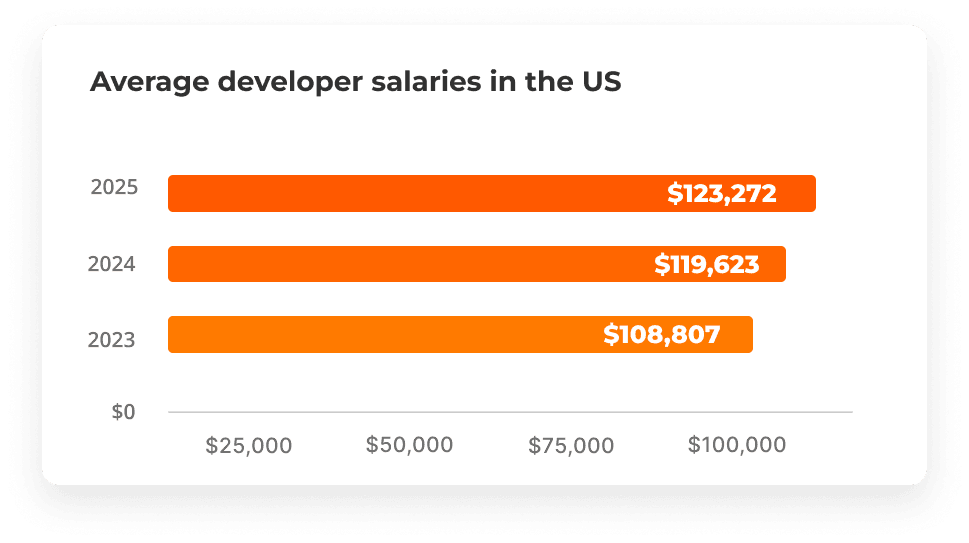
Location-specific benefits
Besides saving 50–70% on development costs, AgileEngine’s remote software experts come with a range of essential benefits, like speed, flexibility, scalability, and specialized expertise.
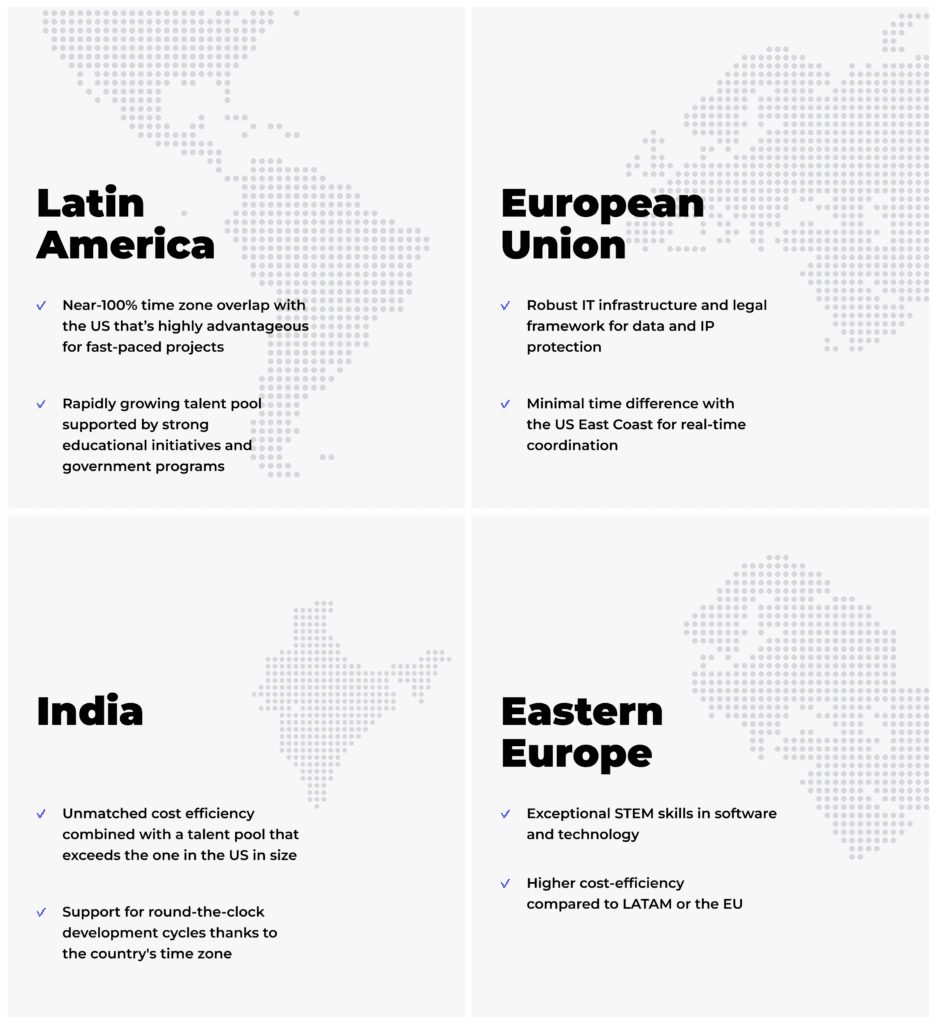
How to select the right vendor
Selecting the right dedicated development team vendor requires systematic evaluation across multiple dimensions.
Technical capabilities assessment
- Portfolio review with similar project examples
- Technical skill validation through coding assessments
- Architecture and design capability demonstration
- Quality assurance processes and standards
- Development methodology and tool proficiency
Business stability evaluation
- Financial stability and company background verification
- Client retention rates and long-term partnership examples
- Industry certifications and compliance standards
- Legal standing and contract fulfillment history
- Scalability and resource availability demonstration
Operational excellence indicators
- Communication protocols and response time standards
- Project management methodologies and tools
- Risk management and contingency planning processes
- Knowledge transfer and documentation practices
- Performance monitoring and reporting capabilities
Red flags
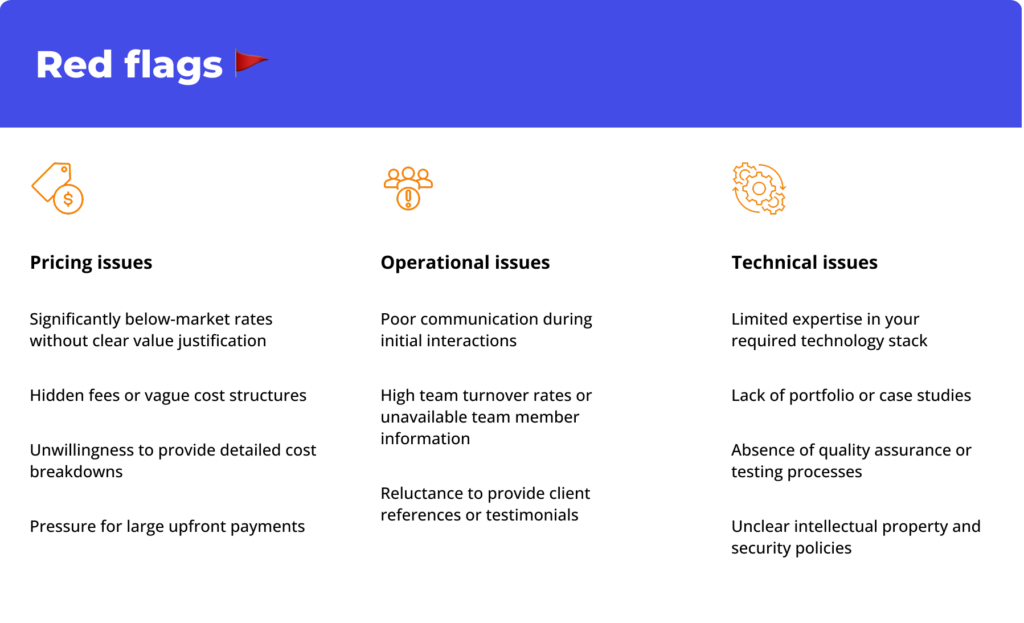
How to ensure the long-term success of dedicated team engagements
A dedicated development team engagement is not a one-off transaction — it’s a living partnership that evolves through trust, transparency, and shared goals. Over time, collaboration deepens and the team can transition from a pure execution role to a high-impact strategic partner.
Level 1: Vendor relationship (months 1–6)
In the initial stage, the focus is on establishing clear communication channels and consistent delivery processes. Teams align on requirements, expectations, and quality standards while building confidence in each other’s workflows.
Key success metrics: On-time delivery, adherence to specifications, and predictability in output.
Level 2: Collaborative partnership (months 6–18)
Once trust and operational stability are in place, the dedicated team begins to operate with greater autonomy. They gain access to the business context behind the projects and contribute to strategic discussions.
Key success metrics: Impact on business outcomes, contribution to innovation, and efficiency improvements beyond the initial scope.
Level 3: Strategic alliance (18+ months)
At this stage, the dedicated team becomes an extension of the client’s leadership in technology planning. They participate in strategic decision-making, proactively propose improvements, and drive innovation that supports the company’s competitive positioning.
Key success metrics: Tangible competitive advantages, accelerated go-to-market, and measurable market impact.
Dedicated teams can become valuable innovation partners when you:
- Leverage their knowledge to provide well-informed recommendations for platform modernization and technical debt reduction
- Use their expertise to evaluate the viability of new features and architectural decisions
- Utilize their familiarity with your tech stack to quickly validate high-priority concepts and ideas
- Benefit from their exposure to diverse projects and technologies to identify relevant emerging solutions for your domain
A final word
In 2025, the speed of technological change — especially with AI redefining capabilities overnight — demands more than just hiring talent; it requires building strategic partnerships. With the right partner, dedicated teams can evolve from simple service providers into true drivers of innovation.
Staying ahead of disruption starts with the right team. Schedule a free consultation with AgileEngine and see how our dedicated teams can accelerate your next phase of growth.
Staying ahead of disruption starts with the right team. Schedule a free consultation with AgileEngine and see how our dedicated teams can accelerate your next phase of growth
FAQ
1. How quickly can a dedicated team start working on my project?
The start time depends on the skills, seniority, and availability of the specialists you need. Our proprietary agentic AI platform can accelerate the time-to-hire by up to 60%, ensuring your team is onboarded faster without compromising quality.
2. Will a dedicated team work in my time zone?
Yes. We offer global coverage, with talent pools across the Americas, Europe, and India.
3. How do I maintain control over a remote dedicated team?
You retain full project ownership. Our teams integrate into your workflow, use your preferred tools, and provide regular progress updates to ensure transparency.
4. Can I scale my dedicated team up or down mid-project?
Absolutely. One of the core benefits of this model is flexibility — you can adjust team size and skill composition as your needs evolve.
5. How is intellectual property protected?
All work is governed by strict contracts and NDAs, ensuring that you retain 100% IP ownership and that all data and code are secured according to international standards.






